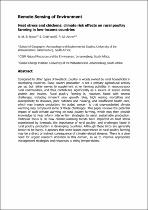 ResearchSpace
ResearchSpace
Heat stress and chickens: climate risk effects on rural poultry farming in low-income countries
JavaScript is disabled for your browser. Some features of this site may not work without it.
- ResearchSpace
- →
- Research Publications/Outputs
- →
- Journal Articles
- →
- View Item
| dc.contributor.author |
Nyoni, NMB

|
|
| dc.contributor.author |
Grab, S

|
|
| dc.contributor.author |
Archer, Emma RM

|
|
| dc.date.accessioned | 2018-09-25T10:33:10Z | |
| dc.date.available | 2018-09-25T10:33:10Z | |
| dc.date.issued | 2018-04 | |
| dc.identifier.citation | Nyoni, N.M.B., Grab, S. and Archer, E.R.M. 2018. Heat stress and chickens: climate risk effects on rural poultry farming in low-income countries. Climate and Development, https://doi.org/10.1080/17565529.2018.1442792 | en_US |
| dc.identifier.issn | 1756-5529 | |
| dc.identifier.uri | https://www.tandfonline.com/doi/abs/10.1080/17565529.2018.1442792 | |
| dc.identifier.uri | http://hdl.handle.net/10204/10417 | |
| dc.description | Copyright: 2018. Taylor & Francis. Due to copyright restrictions, the attached PDF file only contains the abstract of the full text item. For access to the full text item, please consult the publisher's website. The definitive version of the work is published in Climate and Development, https://doi.org/10.1080/17565529.2018.1442792 | en_US |
| dc.description.abstract | Compared to other types of livestock, poultry is widely owned by rural households in developing countries. Rural poultry production is not a primary agricultural activity per se, but rather serves to supplement other farming activities in resource-poor rural communities, and thus contributes significantly as a source of scarce animal protein and income. Rural poultry farming is, however, faced with several challenges, including inherent slow growth rates, high rearing mortalities and susceptibility to diseases, poor nutrition and housing, and insufficient health care, which may impede production. An added concern is that unprecedented climate warming may compound some of these challenges. This paper reviews the potential impact of such climate warming on rural poultry farming, which may then provide knowledge to help inform intervention strategies to assist sustainable production. Particular focus is on how climate-warming trends have impacted on heat stress experienced by livestock, the importance of rural poultry, and challenges faced in rural poultry production in developing countries. Although these birds are generally known to be hardy, it appears that some losses experienced in rural poultry farming may be a direct or indirect consequence of climate-related stresses. There is a clear need for urgent research attention in this domain, so as to improve appropriate management strategies and responses to rising temperatures. | en_US |
| dc.language.iso | en | en_US |
| dc.publisher | Taylor & Francis | en_US |
| dc.relation.ispartofseries | Workflow;21000 | |
| dc.subject | Climate change | en_US |
| dc.subject | Heat stress | en_US |
| dc.subject | Poultry | en_US |
| dc.subject | Subsistence | en_US |
| dc.title | Heat stress and chickens: climate risk effects on rural poultry farming in low-income countries | en_US |
| dc.type | Article | en_US |
| dc.identifier.apacitation | Nyoni, N., Grab, S., & Archer, E. R. (2018). Heat stress and chickens: climate risk effects on rural poultry farming in low-income countries. http://hdl.handle.net/10204/10417 | en_ZA |
| dc.identifier.chicagocitation | Nyoni, NMB, S Grab, and Emma RM Archer "Heat stress and chickens: climate risk effects on rural poultry farming in low-income countries." (2018) http://hdl.handle.net/10204/10417 | en_ZA |
| dc.identifier.vancouvercitation | Nyoni N, Grab S, Archer ER. Heat stress and chickens: climate risk effects on rural poultry farming in low-income countries. 2018; http://hdl.handle.net/10204/10417. | en_ZA |
| dc.identifier.ris | TY - Article AU - Nyoni, NMB AU - Grab, S AU - Archer, Emma RM AB - Compared to other types of livestock, poultry is widely owned by rural households in developing countries. Rural poultry production is not a primary agricultural activity per se, but rather serves to supplement other farming activities in resource-poor rural communities, and thus contributes significantly as a source of scarce animal protein and income. Rural poultry farming is, however, faced with several challenges, including inherent slow growth rates, high rearing mortalities and susceptibility to diseases, poor nutrition and housing, and insufficient health care, which may impede production. An added concern is that unprecedented climate warming may compound some of these challenges. This paper reviews the potential impact of such climate warming on rural poultry farming, which may then provide knowledge to help inform intervention strategies to assist sustainable production. Particular focus is on how climate-warming trends have impacted on heat stress experienced by livestock, the importance of rural poultry, and challenges faced in rural poultry production in developing countries. Although these birds are generally known to be hardy, it appears that some losses experienced in rural poultry farming may be a direct or indirect consequence of climate-related stresses. There is a clear need for urgent research attention in this domain, so as to improve appropriate management strategies and responses to rising temperatures. DA - 2018-04 DB - ResearchSpace DP - CSIR KW - Climate change KW - Heat stress KW - Poultry KW - Subsistence LK - https://researchspace.csir.co.za PY - 2018 SM - 1756-5529 T1 - Heat stress and chickens: climate risk effects on rural poultry farming in low-income countries TI - Heat stress and chickens: climate risk effects on rural poultry farming in low-income countries UR - http://hdl.handle.net/10204/10417 ER - | en_ZA |





